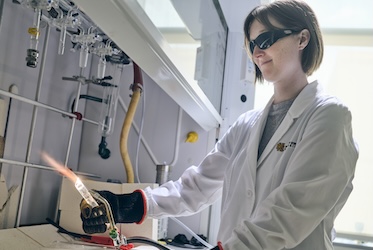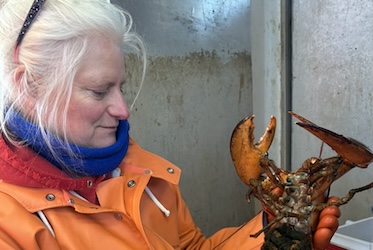

KENNESAW, Ga. | Aug 11, 2017
Environmental Science assistant professor Daniel Ferreira has the answers

Is it really possible to rank the top ten doomsday disasters? The Weather Channel apparently thinks so. Read below for all the answers to your most burning doomsday disaster-related questions about methane, the subject examined by Kennesaw State University’s Daniel Ferreira, assistant professor of environmental science. He appears on the Weather Channel program “Top Ten Doomsday Disasters” Aug. 13 at 8 p.m. #ItsAmazingOutThere
Methane is a molecule containing four hydrogen atoms bonded to a central carbon atom (CH4). Under normal environmental conditions, methane is typically found as a gas. Under certain conditions of temperature and pressure, however, methane can occur as a “hydrate” or a “clathrate” which is technically considered to be a solid, but with the consistency of toothpaste.
Methane is naturally produced when organic matter (remains of dead plants and animals, mostly plants) are buried away from oxygen and exposed to high temperature and pressure. Normally, organic matter is decomposed into CO2, but if organic matter gets buried, such as by a landslide or at the bottom of the ocean, where there is no free oxygen, the carbon can instead bond with hydrogen and form compounds called hydrocarbons. This would include natural gas (of which methane is one) as well as coal and oil.
Methane can be found deep underground in rock formations such as the Marcellus Shale in Pennsylvania and New York, or underneath the bottom of the ocean on top of oil deposits.
Methane's big threat to the environment is its potency as a greenhouse gas. When people talk about climate change, they typically discuss CO2, which is the most plentiful greenhouse gas in the atmosphere (except for water vapor, depending on where you are). Methane, while present in smaller quantities than CO2, is much more powerful. One molecule of methane can trap about 20 times as much heat as one molecule of CO2. This makes methane potentially a very deadly player in the climate change we are currently experiencing, especially if a lot of it gets released at once.
If I wanted to find methane on campus, I just have to go to a chemistry lab. When you plug your Bunsen burner into the gas outlet and light it up, it’s mostly methane that’s combusting to make the flame. Natural methane is commonly produced in landfills. The nearest one to campus would be the Dixie Landfill in Woodstock. Georgia is not particularly rich in natural gas deposits, but there is quite a bit of fracking for natural gas production in Alabama right next door. Fracking is short for hydraulic fracturing, which is a technique for the extraction of natural gas deposits by pumping high pressure steam and chemicals into bedrock to widen the natural fractures, making it easier to extract the gas.
There are natural seeps of methane all over the place in nature. If you’ve ever heard of marsh gas or swamp gas, those are usually natural seeps of methane (with a little hydrogen sulfide mixed in) produced by the anaerobic decay of organic matter in swamps and bogs. These can sometimes catch fire and create small flames in these areas that seem to appear out of nowhere. In ancient times, people who saw these spontaneous bursts of flame or light in swamps thought they were magical creatures and called them will-o'-the-wisps. But methane would have to reach a pretty high concentration to “explode.” It’s flammable, but not generally explosive under normal conditions.
If you had a build-up of methane in a confined space like a cave, where it couldn't easily vent and mix into the atmosphere, it could conceivably reach high enough levels to cause an explosion. This is especially true if the methane is building up in an area where there are other explosive substances like coal or coal dust. Methane build-ups have been known to cause mining disasters.
It’s believed that a methane leak may have caused the recent explosion in the Minnehaha Academy in Minneapolis. The inside of a building, especially one that is tightly sealed for energy conservation, can also be a confined space where methane can build up. If a gas line is leaking and the gas can't easily escape the building, it can lead to serious explosions.
If you suspect a methane leak, get out of the building immediately. Methane is naturally odorless, but methane manufacturers are required to add a compound to commercial methane called mercaptan that gives it an easily detectable smell. So, if you smell gas, leave the vicinity and call campus police. They are trained to deal with situations such as gas leaks.
Methane is a fuel that provides us with heat and electricity, so it does a lot for us. On the scale of fuels, methane is kind of in the middle in terms of environmental friendliness. It is still a fossil fuel and produces CO2, which leads to climate change, but it doesn’t have any of the harmful byproducts that coal does like sulfur oxides or mercury. So, it does have that going for it.
Cows get a lot of flak for producing methane, but livestock farming as a whole only contributes about one-fourth of anthropogenic methane emissions. Combustion of methane for electrical generation makes up about one-third, so we have the animals beat hands down when it comes to contributing methane into the atmosphere. Cows, although they produce the most methane, are not the only culprits in the animal world though. Pigs also produce quite a bit.
Methane and ozone are totally different! Contrary to popular belief (I get this from students in my Intro to Environmental Science course all the time) the ozone layer does not play a role in the greenhouse effect or climate change. Ozone in the stratosphere protects us from harmful UV radiation. Methane typically stays in the troposphere (the lowest layer of the atmosphere) and doesn't typically get into the stratosphere to mess with the ozone layer.
As I explained above, methane has the potential to create catastrophic climate change because it is so much more potent as a greenhouse gas than CO2. If there were a large release of methane, say from methane clathrate deposits in the North Atlantic, it could create a sharp shift in our climate orders of magnitude greater than what we've seen so far from our additions of CO2 into the atmosphere. The shift caused by a large release of methane would be steep and sudden (geologically speaking) and those kinds of sharp changes can wreak havoc on ecosystems. Such an occurrence is believed to be the cause of one of the most dramatic natural climate shifts in history, the Paleocene Eocene Thermal Maximum. Average surface temperatures rose by about 6oC during a period of about 20,000 years during that event. That may seem like a long time to you and me, but in geologic time scales, 20,000 years is basically the blink of an eye.
Research has shown a clear link between fracking and the pollution of groundwater aquifers with methane gas. There is a fantastic set of documentaries by Josh Fox called “Gasland” and “Gasland Part 2” where he explores exactly how bad these situations can get. The homeowners affected by fracking taking place nearby their properties can literally light their tap water on fire – that’s how bad it gets.
Methane is a main constituent in the atmospheres of the gas giants. Jupiter, Saturn, Uranus and Neptune all have significant quantities of methane in their atmospheres.
I would probably put the potential for a large methane release similar to what happened during the Paleocene Eocene Thermal Maximum, in the No.2 or No. 3 slot on my personal list, behind nuclear war and maybe global famine/drought.
–– Robert S. Godlewski
Photo by David Caselli

Kennesaw State assistant professor, lab open doors to hands-on innovation in chemistry

Research conducted by Kennesaw State student could lead to faster, more efficient electronics

Well-traveled lobster the latest point of intrigue in Kennesaw State dean's research

Kennesaw State Honors student builds pathways to learning for children in Cameroon
A leader in innovative teaching and learning, Kennesaw State University offers undergraduate, graduate, and doctoral degrees to its more than 47,000 students. Kennesaw State is a member of the University System of Georgia with 11 academic colleges. The university’s vibrant campus culture, diverse population, strong global ties, and entrepreneurial spirit draw students from throughout the country and the world. Kennesaw State is a Carnegie-designated doctoral research institution (R2), placing it among an elite group of only 8 percent of U.S. colleges and universities with an R1 or R2 status. For more information, visit kennesaw.edu.